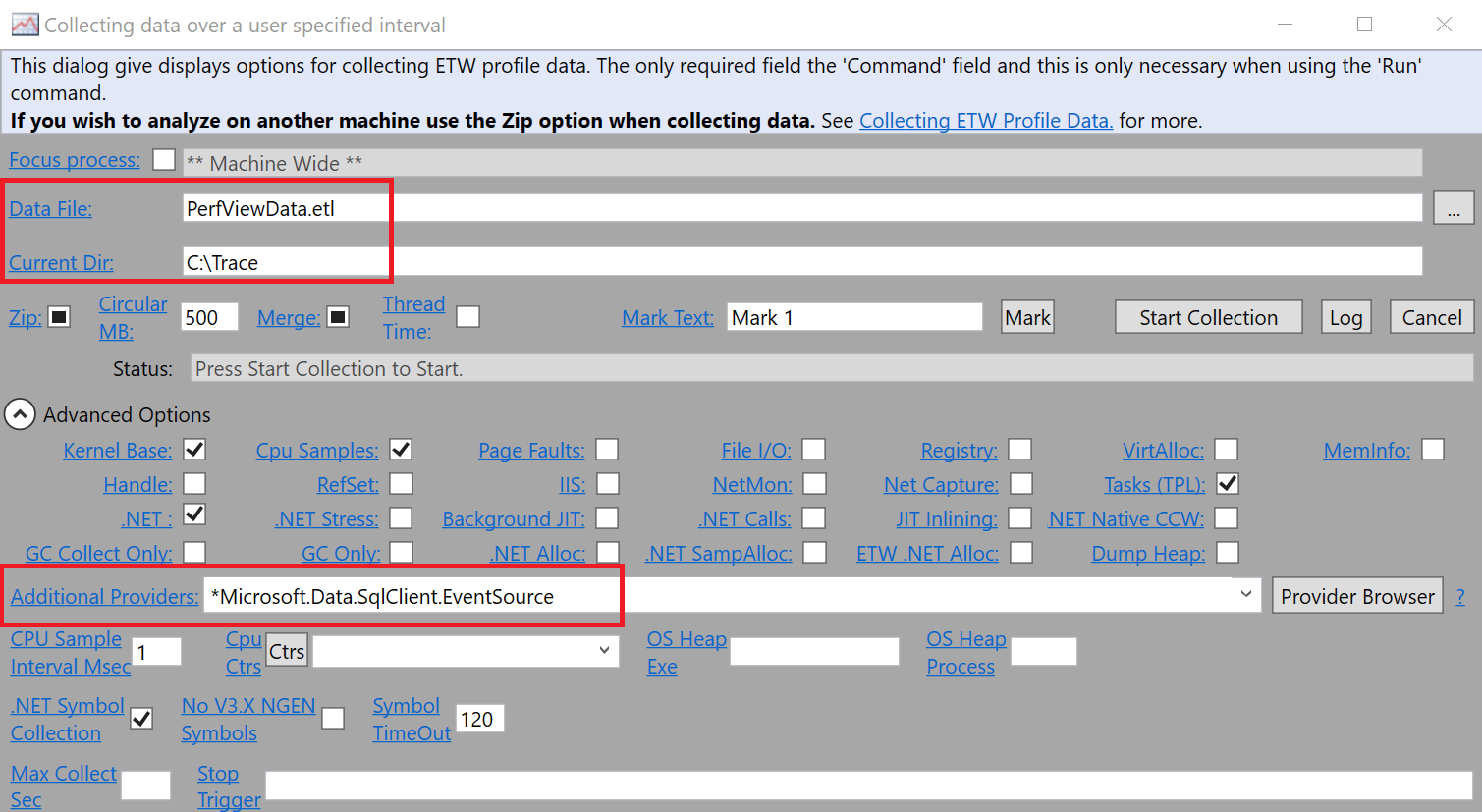在 SqlClient 中啟用事件追蹤
適用於:.NET Framework
.NET
.NET Standard
Windows 事件追蹤 (ETW) 是一種有效率的核心等級追蹤設施,可讓您記錄驅動程式定義的事件以進行偵錯及測試。 SqlClient 支援在不同資訊層級上擷取 ETW 事件。 若要開始擷取事件追蹤,用戶端應用程式應接聽 SqlClient EventSource 實作的事件:
Microsoft.Data.SqlClient.EventSource
目前的實作支援下列事件關鍵字:
| 關鍵字名稱 | 值 | 描述 |
|---|---|---|
| ExecutionTrace | 1 | 開啟/停止擷取命令執行前後的事件。 |
| 追蹤 | 2 | 開啟擷取基本應用程式流程追蹤事件。 |
| 影響範圍 | 4 | 開啟擷取輸入和結束事件 |
| NotificationTrace | 8 | 開啟擷取 SqlNotification 追蹤事件 |
| NotificationTrace | 16 | 開啟擷取 SqlNotification 範圍輸入和結束事件 |
| PoolerTrace | 32 | 開啟擷取連線集區流程追蹤事件。 |
| PoolerScope | 64 | 開啟擷取連線集區範圍追蹤事件。 |
| AdvancedTrace | 128 | 開啟擷取進階流程追蹤事件。 |
| AdvancedTraceBin | 256 | 開啟擷取包含其他資訊的進階流程追蹤事件。 |
| CorrelationTrace | 512 | 開啟擷取相互關聯流程追蹤事件。 |
| StateDump | 1024 | 開啟擷取 SqlConnection 的完整狀態傾印 |
| SNITrace | 2048 | 開啟擷取來自受控網路實作的流程追蹤事件 (僅適用於 .NET Core) |
| SNIScope | 4096 | 開啟擷取來自受控網路實作的範圍事件 (僅適用於 .NET Core) |
範例
下列範例會啟用 AdventureWorks 範例資料庫上資料作業的事件追蹤,並在主控台視窗中顯示事件。
using System;
using System.Diagnostics.Tracing;
using Microsoft.Data.SqlClient;
// This listener class will listen for events from the SqlClientEventSource class.
// SqlClientEventSource is an implementation of the EventSource class which gives
// it the ability to create events.
public class SqlClientListener : EventListener
{
protected override void OnEventSourceCreated(EventSource eventSource)
{
// Only enable events from SqlClientEventSource.
if (eventSource.Name.Equals("Microsoft.Data.SqlClient.EventSource"))
{
// Use EventKeyWord 2 to capture basic application flow events.
// See the above table for all available keywords.
EnableEvents(eventSource, EventLevel.Informational, (EventKeywords)2);
}
}
// This callback runs whenever an event is written by SqlClientEventSource.
// Event data is accessed through the EventWrittenEventArgs parameter.
protected override void OnEventWritten(EventWrittenEventArgs eventData)
{
// Print event data.
Console.WriteLine(eventData.Payload[0]);
}
}
class Program
{
public static void Main()
{
// Create a new event listener.
using (SqlClientListener listener = new SqlClientListener())
{
string connectionString = "Data Source=localhost; " +
"Initial Catalog=AdventureWorks; Integrated Security=true";
// Open a connection to the AdventureWorks database.
using (SqlConnection connection = new SqlConnection(connectionString))
{
connection.Open();
string sql = "SELECT * FROM Sales.Currency";
SqlCommand command = new SqlCommand(sql, connection);
// Perform a data operation on the server.
SqlDataReader reader = command.ExecuteReader();
while (reader.Read())
{
// Read the data.
}
reader.Close();
}
}
}
}
原生 SNI 中的事件追蹤支援
Microsoft.Data.SqlClient 從 v2.1 開始,在 Microsoft.Data.SqlClient.SNI 與 Microsoft.Data.SqlClient.SNI.runtime 中提供了事件追蹤支援。 您可以使用 Xperf (部分機器翻譯) 與 PerfView (英文) 工具,從原生 DLL 收集事件。
從 Microsoft.Data.SqlClient v3.0 開始,可以在用戶端應用程式中使用事件收集工具來啟用事件追蹤,而不需進行任何修改。
使用 Microsoft.Data.SqlClient v2.1 時,必須使用事件來源接聽程式來設定 EventCommand,以啟用事件追蹤。 適用於原生 SNI 的有效 EventCommand 值如下:
// Enables trace events:
EventSource.SendCommand(eventSource, (EventCommand)8192, null);
// Enables flow events:
EventSource.SendCommand(eventSource, (EventCommand)16384, null);
// Enables both trace and flow events:
EventSource.SendCommand(eventSource, (EventCommand)(8192 | 16384), null);
下列範例會在原生 SNI DLL 中啟用事件追蹤。
// Native SNI tracing example
using System;
using System.Diagnostics.Tracing;
using Microsoft.Data.SqlClient;
public class SqlClientListener : EventListener
{
protected override void OnEventSourceCreated(EventSource eventSource)
{
if (eventSource.Name.Equals("Microsoft.Data.SqlClient.EventSource"))
{
// Enables both trace and flow events
EventSource.SendCommand(eventSource, (EventCommand)(8192 | 16384), null);
}
}
}
class Program
{
static string connectionString = @"Data Source = localhost; Initial Catalog = AdventureWorks;Integrated Security=true;";
static void Main(string[] args)
{
// Event source listener configuration is not required in v3.0 onwards.
using (SqlClientListener listener = new SqlClientListener())
using (SqlConnection connection = new SqlConnection(connectionString))
{
connection.Open();
}
}
}
使用 Xperf 來收集追蹤記錄
使用下列命令來啟動追蹤。
xperf -start trace -f myTrace.etl -on *Microsoft.Data.SqlClient.EventSource執行原生 SNI 追蹤範例,以連線到 SQL Server。
使用下列命令列來停止追蹤。
xperf -stop trace使用 PerfView 來開啟步驟 1 中所指定的 myTrace.etl 檔案。 您可以使用
Microsoft.Data.SqlClient.EventSource/SNIScope與Microsoft.Data.SqlClient.EventSource/SNITrace的事件名稱來找到 SNI 追蹤記錄。
使用 PerfView 來收集追蹤記錄
從功能表列啟動 PerfView 並執行
Collect > Collect。設定追蹤檔案名稱、輸出路徑與提供者名稱。

開始收集。
執行原生 SNI 追蹤範例,以連線到 SQL Server。
從 PerfView 停止收集。 根據步驟 2 中的設定產生 PerfViewData.etl 檔案需要一些時間。
在 PerfView 中開啟
etl檔案。 您可以使用Microsoft.Data.SqlClient.EventSource/SNIScope與Microsoft.Data.SqlClient.EventSource/SNITrace的事件名稱來找到 SNI 追蹤記錄。
外部資源
如需如何跨平台追蹤 Microsoft.Data.SqlClient 的另一組範例,請參閱 CSS SQL 網路工具 Wiki (英文)。
如需事件追蹤的詳細資訊,請參閱下列資源。
| 資源 | 說明 |
|---|---|
| EventSource 類別 | 用來建立 ETW 事件。 |
| EventListener 類別 | 提供啟用和停用事件來源事件的方法。 |
意見反應
即將登場:在 2024 年,我們將逐步淘汰 GitHub 問題作為內容的意見反應機制,並將它取代為新的意見反應系統。 如需詳細資訊,請參閱:https://aka.ms/ContentUserFeedback。
提交並檢視相關的意見反應
